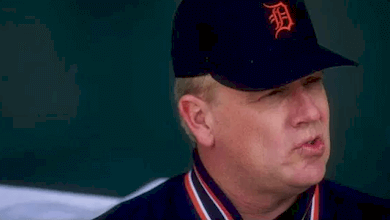
Rookie manager Buddy Bell succeeded Sparky Anderson with the Detroit Tigers in 1996.
Hard to believe it has been over 20 years since Sparky Anderson last managed the Detroit Tigers.
The date was October 1, 1995. The scene was Camden Yards in Baltimore.
The Tigers’ Travis Fryman was at bat in the ninth inning with the bases empty against the Orioles’ Mike Mussina. Detroit trailed, 4-0, with two outs.
Fryman lifted a fly ball to left field, ending the game.
It also ended an era in baseball history.
Well, two eras, really.
It was the final game that the long-running keystone combination of Lou Whitaker and Alan Trammell ever played together.
But the subject of this story is Sparky, or rather, the Tigers’ first year after Sparky. Following nine mostly-splendid seasons with the Cincinnati Reds, and 17 in the Motor City, he was calling it a career.
Where would the Tigers go from there?
For the first time in a long time, the club would be looking for a new skipper.
Among the candidates was 39-year-old Yankee manager Buck Showalter, whose contract was up.
Tom Runnells, the skipper of the Tigers’ Triple-A Toledo farm club, was also expected to get some serious consideration.
The Pittsburgh Pirates, meanwhile, were harboring thoughts of bolting the Steel City. If they did, their manager, Jim Leyland, would perhaps be interested in returning to the Tigers, his original organization.
Tony La Russa of the Oakland A’s was also one of the names bandied about.
All of those guys had managerial experience, but there was a dark horse candidate who had never led a team at any level. His name was Buddy Bell, a star third baseman with Cleveland, Texas, Cincinnati, and Houston from 1972 to 1989.
Bell had been the director of minor league instruction with the White Sox for a couple of years. But he was a favorite of Joe Klein, the Tigers’ general manager, because of his excellent track record working with young players.
In early November, however, Klein was given the boot, officially ushering in the Randy Smith Era. Still, less than two weeks later, Smith announced that the Tigers were going with Bell. He was signed to a two-year, $500,000 contract. Showalter, by comparison, was asking for at least a million per, which scared off the Tigers.
Bell, whom the Tigers had frequently pursued when he was a player, trying to fill a hole at third base in the 1980s, was now coming to Detroit, but as a manager not to be in the lineup.
“There’s a long way to go here,” said Bell, “but I’m very excited about it.”
The team that the 44-year-old Bell was inheriting had finished 60-84 in the strike-shortened 1995 campaign.
But in 1996, they were truly awful.
Detroit’s season got off to a solid start. They were actually in second place, with a record of eight wins and seven losses following a victory at Toronto on April 16.
And then, the nightmare started.
They lost 39 of their next 44 games. That’s right, they went 5-39 over nearly a two-month stretch.
The team righted itself a bit, playing at nearly a .500 clip in July and August. But a September collapse in which they went 4-22 put an exclamation point on a forgettable year.
Let the record show that the 1996 Tigers finished 53-109, dead last in in the five-team American League East. They were a whopping 39 games behind the New York Yankees, who were led by their new manager, Joe Torre. Detroit was 21 lengths behind fourth-place Toronto.
Yes indeed, Sparky got out just in time.
The Tiger offense wasn’t so bad. In fact, they scored 783 runs as a team, which was slightly below the American League average of 872. But it was a season that featured a lot of scoring throughout baseball, with the Steroid Era in full swing. The Tigers blasted 204 home runs, which in most years would be considered a lot. But six other A.L. teams hit more than Detroit that season, topped by Baltimore’s 257.
The Tigers’ lineup featured solid hitters in Tony Clark (27 HRs, .802 OPS), Bobby Higginson (26, .982 OPS), Melvin Nieves (24, .807), and Fryman (100 RBIs). Cecil Fielder hit 26 bombs before being dealt to the Yanks in late July. Speedy rookie Kimera Bartee swiped 20 bags in 110 games. Catcher Brad Ausmus was a solid defender, but didn’t provide much offense.
The problem was that Detroit struck out 1,268 times, far and away the most in the majors. Modern analytics downplays the negative effects of the strikeout, a philosophy which I don’t buy into. After all, what is more unproductive than a strikeout? I suppose a double play is worse, but even a DP can sometimes bring a run home. But that is a discussion for another day.
And what about WAR, you ask? Higginson led the team in that category, at 3.6. If you’re wondering if Trammell had a nice final season in Detroit, well, he didn’t. His WAR was -1.0.
Detroit that year had four players who fanned over 100 times. Fielder, in his half-season, struck out 91 times. Ruben Sierra, whom the Tigers got in the Fielder swap, batted only .222 with one home run in 46 games (Detroit also received Matt Drews, who never played in the major leagues, while Sierra was gone after the season.).
The pitching staff was historically bad, to the tune of a 6.38 team ERA (the major-league average was 4.60). Detroit surrendered 1,103 runs, the second-most in MLB history behind the 1930 Philadelphia Phillies. At least young arms like Jose Lima, C.J. Nitkowski, and Justin Thompson showed promise for the future.
Buddy Bell was right when he said there was a long way to go.
Even Sparky in his prime couldn’t have worked any magic with that stinker of a club.


